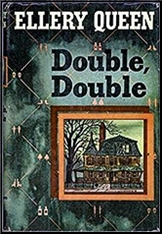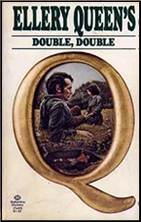Tue 15 Mar 2022

ELLERY QUEEN – Double, Double. Little Brown, hardcover, 1950. Pocket #874, paperback, 1952. Dell, paperback, 1965. Ballantine, paperback, 1975, 1979. Also published in a Signet double novel edition, and as The Case of the Seven Murders (Pocket, paperback, 1958).
A series of anonymous envelopes sent to Ellery Queen from Wrightsville filled with clippings from the local newspaper there is what first piques the well-known mystery writer’s interest. This is followed up by a visit from the daughter of the local “town drunk,†who has mysteriously disappeared and is assumed to have met with foul play and to be dead, his body swallowed up by quicksand at the bottom of a cliff.
The girl is somewhat of a “bird child,†living barefoot and alone in a shack at the edge of a swamp. (You should not be surprised to learn that her name is Rima.) Before the two of them return to Wrightsville, Ellery plays Pygmalion with her, furnishing her with new clothes, up-to-date hair styling and the like.

Wrightsville is a small town somewhere in New England, with small town stores and small town businesses, a local doctor who still makes house calls, and a place Ellery has a strange affinity for, with at least three previous cases having taken place there. The townspeople know him well.
Three deaths have already occurred, one suspicious, the other two not. Before the book is done, a total of seven have taken place. I suppose it does no harm to tell you now that the pattern that Ellery discovers connecting them comes from the nursery rhyme that begins “Rich man, poor man…â€
This being the first Ellery Queen novel I’ve read in a while, I was caught by surprise at how chaotic his detective stories could be: swirling winds of surrealism and the unknown. Added to the mix are suspicion, doubts, small town nostalgia, and karma. The final solution, the one that unravels the mystery at the end, is, in fact, greatly dependent on the latter. Events have happened that even the killer could not control.

The detective work is superb – it is utterly fascinating to read a novel in which so many threads of the story could be so knotted up and elusive – then unsnarled so the pieces all fit together. Except … except for the fact that in an Ellery Queen story the people do not act or react as real people would. They are in a sense both naive and artificial, and they do things that real people would not do – especially the killer, as hard as Ellery Queen the detective does his best to explain his or her thinking.
I do not mean to suggest that this is a bad thing, except perhaps for present day readers who do not understand the worth of a pure puzzle story. You start to read an Ellery Queen novel, and you will find yourself at once in an Ellery Queen world governed by Ellery Queen rules and Ellery Queen ways of thinking.
Opinions on this may vary, but I found myself enjoying this return visit to the world of Ellery Queen, a visit I’ve delayed for far too long. Shame on me.
March 15th, 2022 at 4:23 pm
Nostalgia Time:
I first read Double, Double circa 1966, when I was in high school.
Dell paperback, 50 cents cover price, very attractive little book.
I was a newly regular reader of EQMM, but at this time the books were kind of hard to come by; the rights had scattered to many publishers, and I ask you all to remember what paperback mysteries looked like back then (inappropriate (especially for a young teenager) would be putting it mildly).
As I said above, that Dell PB was kind of sedate for the time, and attracted little notice in study hall, and so I proceeded.
What I remember from that teenage reading – was how funny it was.
I mean, laugh-out-loud funny – and nowhere more so that in the scenes at the Wrightsville Record, the small-town weekly gone wild.
I used to pretend that I was casting the movie/TV show of books that I read, and Double, Double was inspiring indeed:
For Malvina Prentiss, the Record‘s monster publisher, I immediately thought of Virginia Gregg (Jack Webb’s resident harpy for so many years).
And Francis O’Bannon, her browbeaten assistant – the young William Daniels, just starting out back then (he was just free of Captain Nice).
I locked into these two characters because of three brief scenes in Double, Double:
(1) when Ellery, Rima & Co. first arrive at the Record, and encounter Malvina and O’Bannon for the first time.
(2) When Ellery meets up with an intoxicated O’Bannon midway through the case, who tells him Malvina’s backstory, quite hilariously.
(3) After the solution, when O’Bannon gets a suitable revenge against Malvina.
These three passages are some of the funniest writing I’d encountered up to that point in my reading; I wasn’t aware at the time of the division of labor between Dannay and Lee, but subsequent reading has shown that Manny Lee had a savage wit that became a favorite of mine.
For some time after this, I sometimes regaled friends (or at least tried to) with dramatic readings of those three passages; I still get tempted occasionally (not often, but it happens …)
Anyway, that’s my experience with Double, Double).
If you’ve not read it recently, I suggest that you try reading the three O’Bannon passages aloud to friends – especially if they aren’t familiar with the book; even when I was young, I mainly got good results, laugh-wise …
March 15th, 2022 at 5:37 pm
Yes indeed, those were indeed three lovely passages, none of which had any essential connection to the mystery, except as part and parcel of the general offkilterness of Ellery Queen land. I like your casting, but instead of Virginia Gregg who face I often find hard to place (not her voice), I’d go with Lauren Bacall perhaps instead. Maybe Rosalind Russell? William Daniels? Yes!!!
March 15th, 2022 at 5:40 pm
Mike
I wonder if this is the Dell paperback that you read, way back when. I had it ready to go with this review, but there was room for only three images, not four:
March 15th, 2022 at 7:08 pm
Steve:
Got it in one, old pal!
And I wish to God I still had it!
March 15th, 2022 at 7:53 pm
From THE DOOR BETWEEN on the EQ novels had one overweening theme that took them to a level beyond the average mystery, something ignored by many of the Golden Age writers or only delved into briefly, that being Ellery’s growing concern about his role as a detective and how much it requires playing God.
Lord Peter might weep in Harriet Vane’s arms over the execution of criminal he caught, but Ellery brooded, questioned, and agonized over his role not just as man catcher, but also as revealer of the unpleasant truths of the innocent and not so innocent. In that sense the books dared to ask questions even Chandler and Hammett often only suggested.
As that theme develops, particularly in the Wrightsville novels in this quaint small town he has adopted, the series dares to ask equally big questions within the framework of the classical detective story with Ellery often questioning himself and sometimes uncovering the guilty with questions still lingering that can’t be answered by simply identifying who killed whom.
I’ve long thought the Queen novels were more serious and more deserving of attention than the rather dismissive opinion of some critics who seem to read them with a biased eye rather than an open mind.
March 15th, 2022 at 8:16 pm
Ellery certainly broods a lot about this case, but less about his coming to grips with his role as a detective than his failure in solving it. Perhaps in his earlier cases in Wrightsville (this is the fourth of them) the struggles he had with them were greater and along the lines you suggest. I will have to go back and read them again. They are only hinted at in this one. In DOUBLE DOUBLE, the emphasis is almost only on the puzzle, but other things are going on as well.
The title, for example, refers to Ellery realizing early on that there were two ways of looking at each of the events (deaths) and how they were linked together. One way is if Dr. Dodd — looking at him as the common factor — is a villain; the other side of the coin is if he’s the victim, this time around it’s more s also a possibility.
Quoting from pages 207-208 in the Ballantine edition, the bottommost of the three covers I included in the review:
“The persistancy of twoness in this case was certainly remarkable. Either-or. Obverse or reverse. Even the rhyme had two versions. The last line of the second verse had two punctuations. And now there had been two witnessings of Dodd’s will, on two successive days
“In any case each suspect may be two-faced, each piece of evidence may be double talk, each act may conceal a double cross, each motive may be double-dyed, each clue double-edged. […] Each death offered two faces, the story of each victim was twice-told depending on the twin choice of viewpoints.”
And Ellery becomes outright metaphysical when it comes to how events ran out of the killer’s control when it came to killings and how they followed the pattern of the nursery rhyme. On page 229 he explains:
“Where does coincidence end and the force of circumstances begin? It’s a fine point. In the last analysis there may be no such thing as coincidence. At least it wasn’t coincidence that kept [the killer’s] pattern going. It couldn’t be. It was too implacably right.â€
NOTE: This is a much longer and revised version of this comment.
March 16th, 2022 at 11:24 am
Though I’d read CAT OF NINE TAILS and a couple of other Queen novels, when I read the (initial three) Wrightsville novels what bothered me, a LOT, was the multiple endings. Ellery gets everything wrapped up, but then, no, wait a minute, that’s not it, here’s a new solution, and…no, just a minute, here’s another solution. I found myself, not amused, saying “just finish it already!â€. Actu, I like the earlier novels better, such as SPANISH CAPE.
March 16th, 2022 at 11:41 am
Whereas for me, I love those mysteries with multiple false solutions. Everyone has their own personal likes and dislikes. Otherwise what a dull world!
Speaking of SPANISH CAPE, though, back in the mid-60s, I’d read all of the EQ novels but that one, and rather stupidly, I said to myself that I wouldn’t read it, because I’d have read them all and would have nothing left to look forward to. And here it is, some 60 years later, and I still haven’t read it, while having forgotten the story lines of almost all of the others and plenty to look forward to.
March 16th, 2022 at 6:22 pm
In the first version of this review, I said that Wrightsville is a small town in New York State. When I decided to check that out some more, I discovered that most sources said it was in New England. Anywhere but Connecticut would probably be too far from New York City, but no one was that specific. Does anyone know more than this?
July 31st, 2024 at 2:45 am
Feels like a bit of a cheat, with the last few murders fitting the rhyme even when the killer had no such intention.